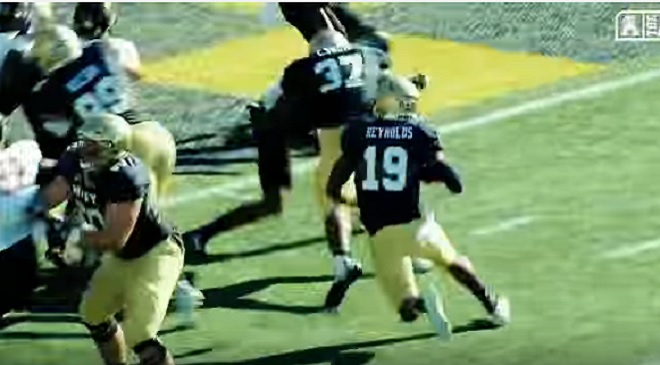In this season’s college football record shop, the option offense is a piece of classic vinyl, unearthed from a milk crate of yesteryear’s hits.
Put it on the turntable, give it a spin, and a few tracks in you ask yourself, why isn’t more contemporary music like this?
The success of option teams this season suggests a revival of the rush-based scheme. Squads around the nation at different levels are flourishing by strumming this classic tune, whether it’s competing for conference championships or upsetting marquee foes.
No. 15-ranked Navy leads the way of the option revival, riding a 348-yard per game to a 9-1 record and very real shot at a New Year’s Six bowl. Quarterback Keenan Reynolds is a veritable option rock-star, having already set the NCAA career record for rushing touchdowns and making a case for the Heisman Trophy.
Reynolds and Mids and wrap up the American Athletic Conference’s West division bid into the league championship game with a win over Houston Friday.
Houston head coach Tom Herman is tasked with prepping his Cougars to face the music.
“We’ve been working on it for a long time,” he said. “We had some Navy periods during spring practice for our defense. We had some segmented Navy periods during training camp, where we introduced the triple-option, and then every Sunday…for the last 8-to-10 weeks, [Houston defenders] have been introduced a little bit at a time.”
Dedicating practice periods to a Week 13 opponent as far back as spring might seem unorthodox, but it’s a necessary game plan to avoid the shell-shock of facing an option on just one week of preparation.
Fellow American Athletic head coach, Ruffin McNeill of East Carolina, echoed Herman’s sentiment. He said the Pirates began prepping for their Week 3 date with Navy early in the offseason.
Of course, Week 3 and 13 are worlds apart in the course of a season. Preseason preparation for facing an option attack in the season’s first month is more intense, as Herman witnessed at Ohio State a season ago.
The Buckeyes opened their 2014 championship season with a 34-17 win over Navy that was much more competitive than the final score indicates.
“At Ohio State, literally every day during training camp our defense had 10, 15, sometimes 20 minutes…working on Navy,” Herman said. “Then, as training camp winds into game week preparation, it was 45 minutes to an hour.”
An early-season matchup with the offense requires hyper-focus. Preparing for it later in the slate is more of slow-burn.
“When the schedule first came out, we knew we were going to have to make some adjustments through the entire season just to give our kids a chance to be ready to go on Friday,” Herman said.
That’s serious diligence for slowing down one offense in a 12-game season, but necessary because of the scheme’s uniqueness.
A recurring theme among coaches tasked with slowing option opponents is just how different the offense is than the spreads prevalent around college football at present.
Navy head coach Ken Niumatalolo, too, attributes some of the Mids’ success to the option’s divergence from more popular schemes.
“People don’t see it week in and week out,” he said. “Everybody’s in the [shotgun], in the spread.
“It’s allowed us to be successful from the standpoint people aren’t familiar with it.”
Indeed, the option club is exclusive. But it’s also successful. Consider some of the programs around the nation spinning the option record:
AIR FORCE: 8-3, 332.7 rushing yards per game. The Falcons are bound for their eighth bowl game in nine years, and headed to their first Mountain West Championship Game appearance in program history.
GEORGIA SOUTHERN: 7-3, 364.3 rushing yards per game. Longtime Div. I-AA/FCS powerhouse Georgia Southern is on course for a second 9-win season in as many years since moving up to FBS. The Eagles led the nation in rushing yards.
NEW MEXICO: 6-5, 234.7 rushing yards per game. Arguably the worst program in FBS a few years ago, Bob Davie’s implementation of a triple-option transformed the Lobos in short order. They are headed to their first bowl game in eight years.
Another noteworthy example on the national stage this season: FCS program The Citadel beat the SEC’s South Carolina throwing just three passes out of its option base. The Bulldogs are the second option team from the FCS to upset an SEC foe in the last three years.
The Citadel’s win serves as a case-study for why some programs run the option. Its nuances can negate speed and size advantages for opposing defenses, particularly through one common phase of the scheme.
“Very, very difficult obviously with the cut-blocking,” said Arizona State head coach Todd Graham. “Those are things you just don’t see.”
Graham’s Sun Devils drew option opponents Cal Poly and New Mexico in back-to-back weeks this season. The Mustangs and Lobos gained 284 and 184 rushing yards against Arizona State — the Sun Devils’ two highest yields of the season.
“It really requires you to play a different style of football — one that requires you be really, really disciplined,” Graham said.
Discipline is necessary to pinpoint and avoid those dreaded, low-angle cut-blocks, which impede defenders’ route toward the ball-carrier.
Defensive discipline is also vital in pursuit of the ball-carrier, particularly the quarterback. Over-commitment to the quarterback keeper results in a last-second pitch to a back, and quickly turns minimal gain into big yardage.
All option offenses primarily take to the ground, but that doesn’t mean all options are the same. Far from it.
Niumatalolo said not many teams in college football line up with the quarterback directly under center, and that includes some option teams. At Navy, the option starts out of a Flexbone formation with the quarterback under center, a fullback behind, and a slotback and a wingback.
Service academy rival Air Force will run out of single-back formations with multiple receivers wide, or with the quarterback lined up in the shotgun.
Troy Calhoun’s teams haven’t been shy about airing it out. Four-year starter Tim Jefferson attempted 183 passes in 2011, which is more than Navy’s Reynolds has thrown in the last two years combined.
Air Force quarterback Karson Roberts attempted 16 passes in the Falcons’ 37-30 upset of Boise State last Friday, completing nine of them for 279 yards and two touchdowns.
The aerial assault was Calhoun’s surprise plan of attack for a Boise State defense seeing an option team for the second time in as many weeks. The Broncos were gashed for four rushing touchdowns the week prior in a loss to New Mexico.
Making good on Davie’s preseason promise to introduce more passing into the offense, the Lobos didn’t rely on the run nearly as much against Boise State this season as last, when they rushed for an incredible 505 yards vs. BSU.
Quarterback Austin Apodaca transferred to New Mexico from pass-happy Washington State, and he still has the freedom to wing it from out of the shotgun. The big difference now is he typically has a running back lined up alongside him — it’s iffy in Washington State’s air-raid — and the Lobos typically line up a slotback to set up option.
The incorporation of spread and traditional option elements together is something New Mexico offensive coordinator Bob DeBesse did successfully in the same role at Sam Houston State.
There, the national semifinal Bearkats averaged nearly 37 points per game with an innovative, hybrid look New Mexico is coming closer to emulating.
Sam Houston State’s head coach then was Willie Fritz, now at Georgia Southern. Georgia Southern’s long staked its reputation on running the most prolific option offense in Div. I-AA, first under legendary Erk Russell, then under former Navy and current Georgia Tech coach, Paul Johnson.
The Eagles strayed from the option in the mid-2000s, but after a brief, failed attempt at running a pro-style, Jeff Monken reinstalled the option.
Fritz is flourishing in Statesboro since taking over for Monken (now at Army), staying true to the program’s identity while moving into the future. Nicole Auerbach of USA Today took a look into the evolution of Georgia Southern’s offense under Fritz that I recommend everyone give a read.
When referring to an option offense, know that each variation is unique, much like different pieces of music. And, like a musical act, option teams must constantly update their style to avoid growing stale.
A great option program like Navy continues to succeed even when opponents know what it runs is because it’s “evolved over the years,” as Niumatalolo described.
“We’ve been doing this so long, and we’ve seen everything you can throw at us,” he said. “Things that have given us trouble over the years, we’ve tinkered with.”
The success these programs have with the option begs the question: When will the Power Five pick up on it?
Paul Johnson’s had success doing just that at Georgia Tech. This year’s struggles aside, the Yellow Jackets have been consistent in Johnson’s tenure with highs of ACC and Orange Bowl championships.
Niumatalolo said the option is less prevalent around college football because air-raid and other spread attacks are seen as more exciting.
However, nothing excites fans more than winning, and the success of option teams in the Group of Five could soon carry over into the Power Five.
Coaching hire rumors should be taken with a grain of salt, but Calhoun and Fritz both getting considerable run in association with a Big 12 opening, Iowa State, suggests a new embrace of the option.
Not long ago, college football’s absolute pinnacle programs thrived running variations of the option. Barry Switzer’s great Oklahoma teams worked option schemes out of a Wishbone formation in the 1980s.
The Sooners have been just fine adapting to air-raid schemes under coordinator Kevin Sumlin, Kevin Wilson and now Lincoln Riley, but not every one-time option Goliath has fared so well abandoning the system.
Consider Oklahoma’s former Big 8 rival, Nebraska.
Nebraska’s last Heisman Trophy winner, Eric Crouch, operated out of the option. So did predecessor Tommie Frazier, who captained two of the most dominant teams in college football history to a pair of national championships in the 1990s.
Nebraska football has never been the same since Tom Osborne-successor Frank Solich was fired early last decade, ending the Cornhuskers’ ties to the option in the process.
Should Mike Riley’s pro-style vision not work in Lincoln, Nebraska brass should consider going retro to chart the course of its future.
Fashions come back in style. So, too, does music. Why not offenses?




[…] Crouch rode to the 2001 Heisman, is rare in today’s spread-dominated landscape. But for Navy, and a handful of other programs, it’s become the great […]